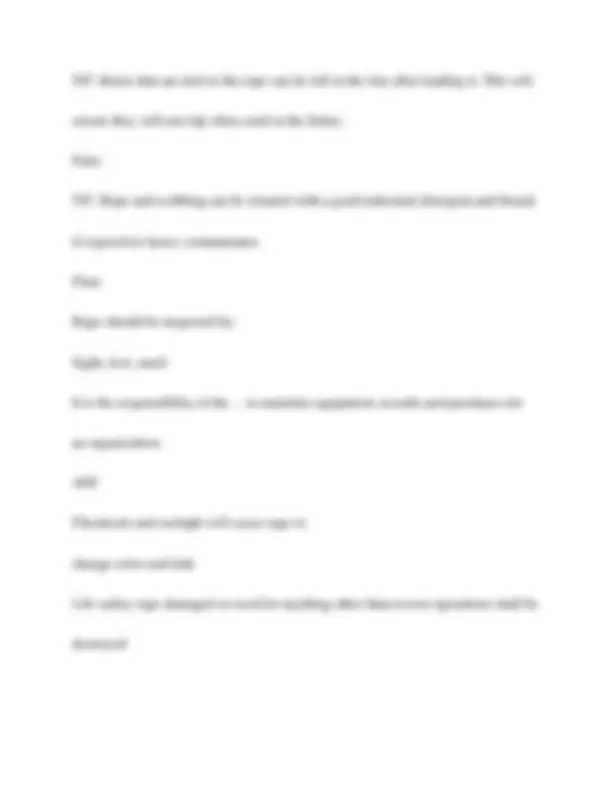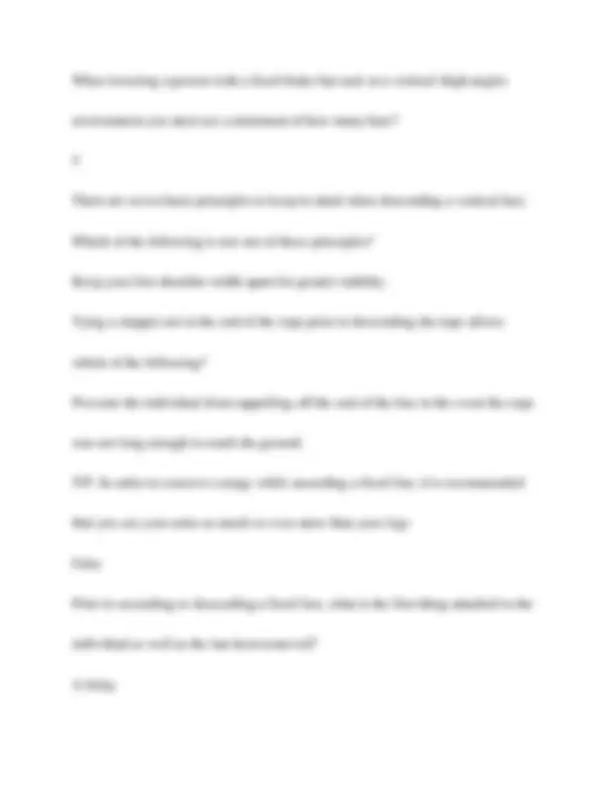













Study with the several resources on Docsity

Earn points by helping other students or get them with a premium plan


Prepare for your exams
Study with the several resources on Docsity

Earn points to download
Earn points by helping other students or get them with a premium plan
Community
Ask the community for help and clear up your study doubts
Discover the best universities in your country according to Docsity users
Free resources
Download our free guides on studying techniques, anxiety management strategies, and thesis advice from Docsity tutors
A series of questions and answers related to rope rescue operations, focusing on equipment, techniques, and safety procedures. It covers topics such as rope inspection, harness types, knot tying, and belay systems. The material is presented in a question-and-answer format, making it useful for quick review and knowledge assessment. It is designed to test understanding of essential concepts in rope rescue, providing a practical resource for training and certification preparation. The document emphasizes safety protocols and best practices, ensuring rescuers are well-prepared for real-world scenarios. It is a valuable tool for reinforcing learning and improving performance in rope rescue operations. The content is structured to facilitate easy comprehension and retention of critical information.
Typology: Exams
1 / 19

This page cannot be seen from the preview
Don't miss anything!












All riggin shall have how many checks prior to Loading? 3 All equip. that falls 3 ft onto a hard surface shall be checked for: Burs, sharp edges, dirt, contaminates, lose parts and deformaties Rope deployed from the anchor point to the ground should be deployed: So only the amount needed is with a dynamic anchor Helmets used for rope rescue should be: Lighter in weight Rope gloves shall be Sturdy formfitting gloves with a leather palm T/F: Fall protection (travel restraint) at the edge shall be long enough for the edge attendant to go over the edge and no farther False A class one harness is designed to stop rescuer when he:
Reaches the edge T/F: Class two harnesses are designed for 600 lb loads and will not keep the rescuer in an up-right position if they become unconscious. True Class three harnesses are: Designed to keep the rescuer or victim in an up-right position T/F: A person that falls in a harness and is suspended and unable to stand on a solid surface should lift their legs into a sitting position and avoid moving. True T/F: When working in a harness with free mobility a person should keep your legs moving as much as possible True T/F: A person that falls and is trapped and unable to lift their legs should squeeze their legs legs every 5 seconds until help arrives True
T/F: Care should be taken when rope is under tension not to allow a second rope under tension (a line) to run across the stationary rope under tension. This will cause a nylon on nylon situation that can burn through a rope quickly True Most rope failures are caused by: Abrasion Rope that will lose strength when wet is: Nylon Polyester handles shock loads: Not as well as nylon Pylopropylene rope: Has a good chemical resistance Examples of natural fiber ropes include: Cotton, sisal , manila Laid rope can be damaged by abrasion easier because: 100% of the ropes fibers come to the surface at some point along its' length
Braided ropes are/have: easy to pick bundles in soft braids Kernmantle construction consists of a: continuous core of fibers Major factors affecting rope strength include: History, diameter, type of construction and material used Rope with a 20 kN T rating (old L rating) are designed with a minimum tensile strength of: 4496 lbf Rope with a G rating of 8992 lbf has a kN rating of: 40 The qualities of good knots, bends and hitches are: Determined by the ease of tying and untying after loading The figure-8 is the strongest loop knot when tied: with an inside bight The butterfly knot is designed for:
A locked carabiner A double overhand knot is also referred to as a barrel knot, back-up knot, safety knot What type of carabiner is used when creating a munter hitcher Extra large locking steel carabiner T/F: A clove hitch when tied around an object and loaded needs to be backed up or it may work work loose True 8mm & 9mm accessory cord is Covered in the cordage institute rope construction standards Besides holding or capturing a load line, prusiks are used for: Self-rescue Accessory cord used in the construction of a load releasing hitch can be either 8mm or 9mm T/F: A load releasing hitch made with one inch tubular webbing can be used with tandem prusiks for belay operations with rescue loads over 450 lbs
False T/F: Load releasing hitches are constructed with carabiners only False T/F: Tandem prusiks can only be used in conjunction with a prusik minding pulley False T/F: Block - Creel construction refers to rope with a continuous filament fiber construction in both the kern and mantel of a rope True A knot with a small internal radius bends, as those found in square knots or over hand knots will .... when tied in 1/2 inch kernmantle rope be weaker T/F: After each use, rope should be reversed in the bag True Over a period of time as rope or accessory cord is used, it will: Become shorter
Besides a minimum diameter of 11mm G rated rope, NFPA requirements also call for Rope diameter, elongation, minimum temperature A 15:1 ratio for rope strength use to be a NFPA standard but a more realistic ratio is suggested to be 10: T/F: Knots that are tied in the rope, dressed and set prior to loading can be left in the rope but knots that have been loaded should be removed and the rope allowed to rest prior to retying the knot. True A knot used to isolate a bad spot in the line in an emergency is a: lineman's loop T/F: the strongest of all the loop knots is the figure-8 on a bight true The strongest type of webbing construction is: Tape
The strongest tubular webbing construction is Shuttle loom Just like with all equipment, care and maintenance of webbing is: manufacture A knot used to join webbing together is referred to as a/an Water knot, ring-bend knot, Overhand bend knot T/F: Like with all knots, the loose end used to tie the webbing knot should be secured to the working part of the webbing true A type of knot construction used to join two ends of the webbing together and at the same time create a loop in the end of the webbing is called a frost knot T/F: Webbing can be damaged in the same way rope is damaged and shall be protected all the times with tape webbing abrading quicker than tubular webbing True
When constructing a tandem prusik belay, it is advisable to use a load releasing hitch in the event the tandem prusiks become stuck or jammed T/F: It is acceptable to anchor yourself to the back of your harness and place the belay device in the front lower attachment point in the harness for belay operations. This will help maintain the rescuer in an upright position if they become unconscious. False T/F: Figure 8 descenders can be used as belay devices when a rope is placed in the large opening of the figure 8. False T/F: A mariners hitch is acceptable for tandem prusik belays with rescue loads False When placing tandem triple wrap prusik (T3WP's), the prusik are placed on the line coming from the delta or carabiner and the prusik minding pulley (PMP) that will carry the load with the bridges up and:
both prusiks tied the same T/F: A belay line is always the first line attached to the rescuer and the last thing taken off the rescuer. True The maximum amount of slack allowed in the belay line is: 1 foot T/F: Dynamic rope used for belay operations has a laid kern construction and is covered under NFPA 1983 False A bottom belay will will not arrest a fall if the main line fails. Engineered shock absorbing equipment is recommended by NFPA anytime there is a potential fall factor greater than . Carabiners used in fall protection equipment designed for tower climbing shall per OSHA be designed with:
Prusik size for 12.5mm rescue line in belay operations as used in this program is constructed of: 8 or 9 mm accessory cord T/F: A six bar rack is an acceptable means of belaying in a rescue load. False If a rescuer falls 1 foot on 1 foot of slack in a belay line he will: Need engineered equipment to absorb the energy of the fall What NFPA standard is used in reference to ascending and descending a fixed line in a low angle environment? 1006 What diameter of prussic cord is recommended for use as an ascending device on a 12.5 fixed line? 8 mm or 9 mm cord T/F: In an ascending system, the system should use more of your legs and less use of your arms and hands in ascending. True
T/F: In an ascending system, the system should hold you upright transferring the weight of your body to your legs rather than your arms. True T/F: In an ascending system, the system should have attachments to the seat harness and, in some cases, a chest harness. True What is the minimum number of ascenders required for ascending a fixed line in a low angle environment? 1 T/F: Using a three wrap prusik hitch provides more holding power than two wrap prusik hitch but may be more difficult to manipulate. Therefore, it is recommended to use the two wrap prusik for ascending in low angle environments. False When ascending or descending a fixed line in a vertical environment using a prusik hitch you must maintain how many points or contact with the rope at all times? 2
Using a fixed bar rack as a descent device offers many advantages as well as a few disadvantages. Which of the following is an incorrect statement about the fixed bar rack? It difficult to vary the amount of friction while this device is in use. Using a figure 8 device for descending a fixed line may have some advantages over the brake bar rack. Which of the following is an incorrect statement about the figure 8 descent control device? Because of its simple design, it is much easier to adjust the amount of friction while in use. T/F: Ascending and descending a fixed line are relatively easy tasks to learn and can be mastered in a short amount of time if taught by an expert instructor. False